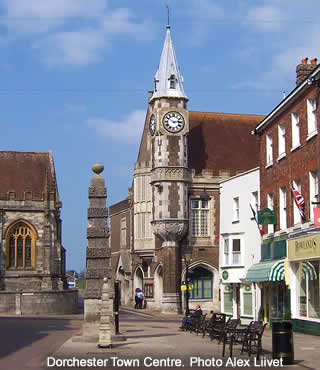Dorchester |
|
 |
|||
A Dorset town with a long, bloody history |
|||||
Listen to this article |
|||||
|
|||||
The settlement which eventually became Dorchester was occupied by Iron Age tribes for thousands of years, but it was the Romans who first stamped a real identity on the place. You can still see evidence of what they built: a section of the town wall, remains of an 8-mile aqueduct, and an entire townhouse. |
|||||
Even more impressive is Maumbury Rings, a large amphitheatre hollowed out of the hillside. It managed to accommodate nearly 10,000 spectators! Judging by the animal and human bone fragments that archaeologists have uncovered here, the events on show were pretty grisly affairs. Maumbury is still used for public occasions today, although live music is generally preferred over gladiatorial combat. |
|||||
These shows are just a single part of Dorchester's often bloody history. In the 1600s, at the start of the Civil War, the Puritans angered the Catholics by executing one of their chaplains and playing football with his head. Later in the same century, Judge Jeffreys came here to deal with survivors of the Monmouth Rebellion, an uprising against King James II. Jeffreys was notoriously harsh; altogether he ordered over 300 executions. 144 of these death sentences were issued on the same weekend! |
|||||
The site of the sentencings eventually became Dorchester's Old Crown Court. An even more notorious case happened here in the 19th century, when half a dozen local labourers formed a sort of trade union, and refused to work for less than 10 shillings a week. This was illegal at the time, so the group was punished by transport to Australia! They became known as the Tolpuddle Martyrs, and their conviction caused a national outrage that paved the way for real trade unions to come into existence. You can see the site of their sentencing during the summer, via the Old Crown Court's guided tours. |
|||||
The various gruesome events of Dorchester's past are explained at the Dorset County Museum. Other exhibits look at local wildlife and geology. There is, for example, a large collection of ancient fossils from the nearby Jurassic Coast. Visitors also learn about Thomas Hardy, Dorchester's local hero. In the late 19th century he wrote novels like Tess of the d'Urbervilles and Far From The Maddening Crowd, propelling him into the upper echelons of the British literary scene. Most of his books were written at Max Gate, his home for forty years. The building's now in the care of the National Trust, and is open to the public. Hardy is further remembered by a statue, up near the Top o' Town crossroads. |
|||||
There are several other museums, which between them offer a surprisingly varied set of exhibitions. They focus respectively on teddy bears, dinosaurs and Tutankhamun. By visiting them all you can meet a full-size T-Rex, Winnie the Pooh, and the mummified body of an Egyptian pharoah. |
|||||
Just west of Dorchester's city centre is an urban development called Poundbury. It was designed by Prince Charles, who owns the land. The settlement aims to be a modern, innovative place, where clever town planning methods foster a strong sense of community. Shops, businesses and houses will all be spread evenly throughout the space. Construction started in the mid-90s, and will carry on until 2025. |
|||||
|
|||||
Dorchester Tourist Information Centre, 11 Antelope Walk, Dorchester, DT1 1BE. Tel: 01305 267 992 |
|||||
|
Pocket Britain is optimised for use on a smartphone or tablet with internet access. All content is subject to copyright. All reasonable methods have been used to ensure information supplied is accurate at the time of publication. However, it is advisable to check information before relying on it. Privacy Policy |